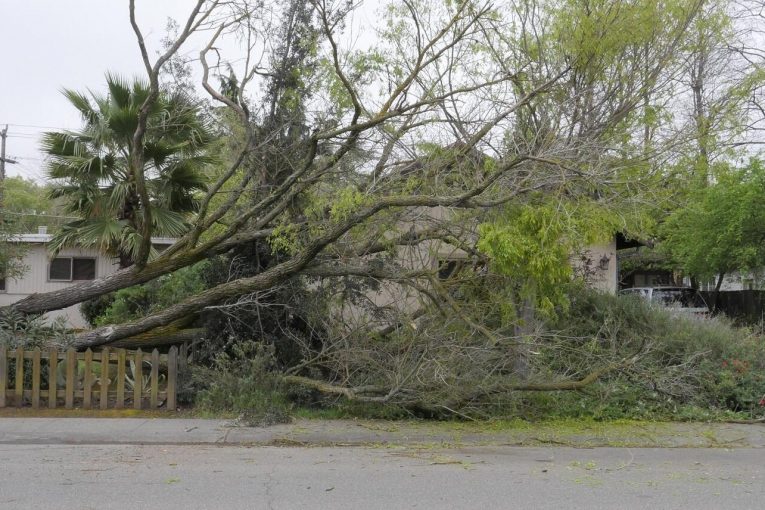
 By Macy Lu
By Macy Lu
DAVIS — On Feb. 23, while playing with her three-year-old daughter in East Davis’ Slide Hill Park, Jennifer Comey, 44, was suddenly struck by a 20-foot long tree limb from an Evergreen Ash tree about 55 to 60 feet tall. Despite the resuscitative efforts from firefighters who arrived shortly after the incident, Comey later passed away at the UC Davis Medical Center in Sacramento.
Comey had moved to Davis from Ohio with her husband, Ted Pitts, and their daughter only 19-months ago after the UC Davis School of Law offered Pitts a librarian job. Her former school friend, Alexandra Siegel described her as “a stay-at-home mom who was really thriving and enjoying her role.”
“I also have two young kids, a 3-year-old and a 5-year-old,” Siegel added. “You go to the playground and that seems like a place where you can let your guard down and relax and let your kids just run around and be carefree. She’s watching her daughter play in the sandbox…it’s just horrifying.”
After the tragedy, the city assigned an independent arborist to assess the ash tree that had dropped the fatal limb. The arborist deemed the tree a hazard given its proximity to the play-area and its history of frequently losing limbs. Removal efforts are currently underway.
“We continue to mourn the loss of a community member, a wife and a mother, because of this tragic incident,” stated Davis Mayor Gloria Partida. “Our parks and tree teams are in the field assessing our trees, and we welcome the community’s help in reporting trees that need evaluation.”
A City of Davis representative informed the Vanguard that inspections and maintenance are performed routinely “on at least a 7-year cycle, if not more often.” These inspections consist of examining “surface roots, main stems, scaffold branches, and the canopy for signs of defects, diseases, and/or pests.”
The city deems trees with “irreparable defects” that may cause tree or branch failures warrant removal. Additionally, if removing a problematic root harms the health of a tree, the city may consider it for removal as well.
Despite this assurance from the city, multiple other community members find the city’s efforts in addressing dried or aged trees lackadaisical at best. Dozens have recently voiced their experiences with fallen limbs from city trees on Nextdoor, a hyperlocal neighborhood social networking site.
One member shared a photo depicting a dense tree branch lying on the ground adjacent to a play-area in Rainbow City Park. Its crash during a particularly windy period in January had knocked down a portion of a wooden fence and the head of a street lamp. From the picture, it appears that rot had infested the joint where the limb connected with the trunk.
“My husband called the city multiple times and the city never took action,” wrote L.B. on February 28, in response to the original owner of the photo. “He said it’s been dropping limbs in that spot for decades too.”
The city representative emphasized that the city typically responds to requests within one to two weeks, even highlighting that for cases deemed “unsafe or a potential public hazard,” the removal period is less than two days.
“We generally receive more service requests following storms and/or wind events,” explained the city representative. Depending on the intensity of the event, they may also do off-cycle inspections.
For example, at the meeting following the windy period in January, the tree commission reported removing 48 trees. At their previous January and December meetings, they did not submit a report requesting the city to remove any trees and they received only a total of three removal requests.
While the influx of service requests and the additional inspections may account for the city’s slower response after a storm, it does not explain the numerous complaints that have gone unanswered over the past several years.
From the response of several Nextdoor commenters, a disparity between residents’ lived experience and the city’s perception of its own overall efficacy clearly exists.
In 2018, another limb of similar weight had fallen from a Slide Hill tree also besides a play-area, right across a pedestrian path. The commenter, P.S., remarked that it was so “huge” and the location of its fall so hazardous, that anyone struck would have “absolutely been mortally wounded.”
Similar to L.B., S.S. in response to this comment, noted that their husband had warned officials that this specific tree was a “disaster waiting to happen,” yet evidently, the city had failed to respond in time.
Rather than diminish in extremity over time, people’s accounts of harrowing experiences with city trees seemed only to grow more grievous.
On Mar. 17, 2020, an enormous Modesto Ash, a city tree, “spontaneously” fell from a neighbor’s yard onto the property of Davis resident Bob Meese. He recalled that there was no wind nor any warning prior to the crash and claimed that either his house or his neighbor’s could have been “severely damaged,” that anyone walking near the tree could have been killed.
A professional landscape architect had warned him earlier that the Modesto Ash typically lasts for about 50 years in the Sacramento area. Thus, with most in his neighborhood already pushing 70 years, the accident involving his neighbor’s tree was no uncanny mishap of nature.
Though the city provided a contractor who promptly removed the tree the day after the incident, they never responded to Meese’s request for an inspection to check for damages to his house.
“It could have been so much worse,” he said. “We were lucky this time.”
He concluded his comment with a message to city leaders to execute a “comprehensive inspection of all of the ash trees in town and a removal, on an expedited timeline, of all of those found to be a danger.”
 The current Chapter 37 “Tree Planting, Preservation, and Protection” of the City of Davis Municipal Code states that while it is the responsibility of a private property owner to irrigate city trees located on their property, they are prohibited from pruning or removing those same trees even if done to “clear branches overhanging private property,” unless previously authorized by the city.
The current Chapter 37 “Tree Planting, Preservation, and Protection” of the City of Davis Municipal Code states that while it is the responsibility of a private property owner to irrigate city trees located on their property, they are prohibited from pruning or removing those same trees even if done to “clear branches overhanging private property,” unless previously authorized by the city.
While this alleviates residents with city trees on their properties of maintenance obligations, it also means if they remove a precarious branch without waiting for city approval, it would technically count as an illegal act.
Another commenter, S.J., shared about a time eight years ago when her relaxing day in Slide Hill with her daughter resulted in a near fatal accident. They had just moved from the balance beam to the sandbox when a large branch fell right where they had been sitting “less than a minute later.”
“I’m surprised the city could not connect the dots after so many repeated incidents like this,” she wrote, “and at least focus on removing limbs overhanging the playground area where they know parents and children congregate.”
In late January, the city’s Urban Forestry Division announced that it will be revising Chapter 37 of the Municipal Code (a draft can be found here). One of the reasons for the update, Urban Forest Manager Rob Cain highlighted, is because “cultural standards” have changed since the ordinance was updated nearly 20 years ago.
The commission hopes editing the language of the division’s practices will help it meet those standards. Other changes include expanding and increasing the specificity of the definitions list, updating the protection standards and enforcement mechanisms, and adding a new mitigation section.
Rearranging various sections to render the ordinance “more user-friendly” so arborists, developers, and private property owners can easily comprehend the material is another priority, stressed Cain.
While the commission has set April 30 as the current deadline for finalizing the ordinance, at their latest meeting, they expressed willingness to extend that deadline in the interest of quality.
Community feedback throughout the revision process is a major concern for the commission; they are currently deliberating changes based both written and verbal public comments. The next community outreach workshop is scheduled for April 8.

Macy is a junior from Orange County, CA, studying Communications and English at UC Davis. She loves meeting people, reading books, and writing creatively.





We need to know more about which existing trees are inappropriate here in the views of the informed including experts who are informed, and which will be even more so in the future. Lots of people know this, but it’s not quite common knowledge. It’s very much related to all the roads we’ve put in and which we can’t seem to maintain – we’ll see what happens with the recent plan on pavement and path rehab – too much and inappropriate, romantic fantasy. Miracle of cheap gas and cheap irrigation, right?
High winds and any tree can create a deadly problem, BUT parks – un-fenced and all – should be presumed to be safe. If not, then this needs to be communicated robustly and in advance. I already proposed to the Chair of the TC what all trees should have a QR code on them from which one can obtain info about its health, inspection, its species, its name (if any… we could get names to name all of them and get funding for that as way to pay for the QR codes!). People without cell phones could call a number to ask about certain trees.
Last but not least, please check out the AP and perhaps BBC style guides for use of the word “accident”. The quote from Mayor Partida is very similar to one she put out right after the tree branch fell and killed my neighbor, except soon after – i.e. after my urging – it was changed to “incident”. To their credit, the senior transportation planner in Public Works and the DPD consistently use the term “incident” (or “crash” etc. when appropriate.). Is the Chair of the BTSSC reading this? At the most recent meeting of that Commission he used the word “accident” to describe, in general, transportation collisions, crashes and/or incidents.
I realize that tree branches can fall at any time (including during the summer, when they suck-up large amounts of water and become heavy).
But as I recall, it was also pretty windy around the area when that branch fell. That’s also why I try to avoid hiking in forests, during windstorms.
And frankly, I’d probably avoid local parks with large trees on very windy days, as well. “Maintained”, or not.
Bottom line is that it seemed that wind was a factor on that day.
I was standing in my backyard years ago, on a warm, still evening, when the about 1/3 of the black walnut tree – in seconds – cracked and fell into the yard. Thousands of pounds of tree, would have killed anyone in its path and it fell just short of the house. Not a hint of wind.
Yeah – I’ve heard that this can occur during hot weather, for the reason I mentioned.
Probably should trim trees that are close to picnic tables. I’m gathering that this person was at, or near that picnic table that was also crushed.
But trees and branches fall all the time, usually without landing on someone. Often landing on houses, parked cars, etc. In Sacramento, for example – every year.
It’s ultimately part of the risk of living around trees. I doubt that the city (or any entity) will trim each and every tree to the point that the risk is drastically reduced. And if they did, there probably wouldn’t be much shade left.
Isolated/rare incidents (regarding this particular outcome) should probably not be be a catalyst of a drastic change in policy, nor would I want to see the city “sued” because they didn’t trim such-and-such tree down to a stump, without expert analysis at least.
Life has its risks.
No s— Sherlock! Life will eventually kill you!
So, I guess I’d kind of disagree with this statement from Todd:
Of course, I think that type of warning might be appropriate before setting foot in parts of (say, for example) Oakland – for an entirely different reason than their namesake “Oak” trees. 🙂 But some people don’t seem to want to acknowledge that, regardless.
Also, we have large numbers of people who don’t even heed warnings regarding masks.
Since most of the new ladder truck staff will have plenty of time between calls maybe we can get them to double as tree trimmers. If we spent the 1-2 million dollars a year the new FF’s are going to cost the city on tree maintenance we could have a well maintained urban forest in short order.
Priorities, priorities.
Now THAT is thinking outside the box. All firefighters should be fully trained arborists. Thumbs up!
And think how well their tree climbing skills will work in getting cats out of trees.
A win-win.